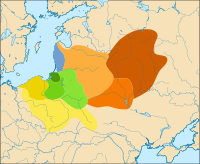Milograd culture
Archaeological culture on present-day Belarus and Ukraine
You can help expand this article with text translated from the corresponding article in Polish. (November 2016) Click [show] for important translation instructions.
- View a machine-translated version of the Polish article.
- Machine translation, like DeepL or Google Translate, is a useful starting point for translations, but translators must revise errors as necessary and confirm that the translation is accurate, rather than simply copy-pasting machine-translated text into the English Wikipedia.
- Consider adding a topic to this template: there are already 1,471 articles in the main category, and specifying
|topic=will aid in categorization. - Do not translate text that appears unreliable or low-quality. If possible, verify the text with references provided in the foreign-language article.
- You must provide copyright attribution in the edit summary accompanying your translation by providing an interlanguage link to the source of your translation. A model attribution edit summary is
Content in this edit is translated from the existing Polish Wikipedia article at [[:pl:Kultura miłogradzka]]; see its history for attribution. - You may also add the template
{{Translated|pl|Kultura miłogradzka}}to the talk page. - For more guidance, see Wikipedia:Translation.

Sambian-Nothangian group
Western Masurian group (Galindians)
Eastern Masurian group (Yotvingians)
Lower Neman and West-Latvian group (Curonians)
Brushed Pottery culture
Milograd culture
Plain-Pottery culture/Dnepr-Dvina culture
Pomeranian culture
Bell-shaped burials group
The Milograd culture (also spelled Milahrad or Mylohrad, also known as Pidhirtsi culture on Ukrainian territory) is an archaeological culture, lasting from about the 7th century BC to the 1st century AD. Geographically, it corresponds to present day southern Belarus and northern Ukraine, in the area of the confluence of the Dnieper and the Pripyat, north of Kyiv. Their ethnic origin is uncertain, but likely to be either Baltic or Early Slavic.
The town of Milahrad (Belarusian: Мілаград), after which the culture is named, is located in the Gomel Region of Belarus.
See also

- Middle Dnieper culture
- Pomeranian culture
- Zarubintsy culture
- Przeworsk culture (Middle and Upper Vistula with Rightbank Oder)
- Chernoles culture (Pripyat' basin, Middle Dnieper and part of Upper Dnieper)[1]
References
- ^ Theory of V. Sedov about Slavic Homeland; "[Projekat Rastko] Valentin V. Sedov: Slavs in Antiquity". Archived from the original on 11 January 2014. Retrieved 11 January 2014.
External links
- Scythians/Sacae by Jona Lendering
- v
- t
- e












